#advice corner
Explore tagged Tumblr posts
Text
W101's Advanced Combat 101: Hanging Effects, Symbols, & How to Read Them
Over the past few years, Wizard101 has been trying to add more variety to gameplay by introducing Advanced Combat, which focuses less on raw damage and more on hanging effects, the additional 'things' that can be present in battle. Because the cards have limited space on them, the developers have decided to use symbols to represent each hanging effect rather than type the entire word out.
This post should serve as a guide and dictionary to these hanging effects and their symbols. Later posts in this series will dive further into the nuances of Advanced Combat, such as the logic of Roshambo and how Gambits and Clears work.

Charms boost the power of outgoing spells. Charms are colloquially just called Blades (since most of time when you see a Charm it WILL be a Blade), but can also include spears, accuracy boosts like Precision or Lightning Strike, and heal boosts like Guiding Light

Blades are a specific kind of Positive Charm that boost your outgoing damage.

Negative Charms, also called Curses (not to be confused with the spell Curse, which is a Jinx), weaken the power of outgoing spells. They're often just called Weaknesses, but also include mantles (which lower accuracy) and infections (which lower outgoing heal).

Weaknesses are a specific kind of Negative Charm that weaken your outgoing damage.
All Charms (positive and negative) appear around the Wizard's head.

Wards reduce the power of incoming damage. These include both Shields which reduce damage by a percentage and Absorbs which nullify a set amount of damage.

Absorbs. Wards that nullify a set amount of damage taken. Rather rare.

Negative Wards, also called Jinxes, increase the power of incoming damage. Like 99% of the time, they're just Traps or Prisms. There used to be spells that Jinxes that weren't either Trap or Prism, but these spells have either changed (like Lord of Night) or only exist as retired Treasure Cards (e.g., Lifebane)

Traps increase the amount of damage you take from an incoming spell.
All Wards (positive and negative) appear around the Wizard's legs.

Heal over Times (often abbreviated to HoTs) heal you over a series of rounds (typically 3 to 5, depending on the spell)

Damage over Times (often abbreciated to DoTs) damage you over a series of rounds (3 to 6 rounds, depending on the spell) Some spells are purely DoT while others have a main hit and DoT component (B Path Fire Dragon is the former, while A Path Fire Dragon is the latter).

Bombs are a variant of DoT that don't do their damage incrementally, but rather go off all at once after a few rounds. A handful of B-Path Myth spells use Bombs, but the only A-Path spell to use them is Blast Off. They're generally not considered good in regular PvE contexts.
All OverTimes appear at the Wizard's feet.

Auras give you a buff in one or two of your stats for a few rounds. Some Auras such as Frenzy and the Aztecan Auras do include a minor drawback.

Negative Auras give you a debuff in one or two of your stats for a few rounds. The most well known Negative Aura is likely Impede, cast by a handful of cheating bosses, but now there are some Negative Auras that wizards can train and cast too
All Auras (positive and negative) appear as a ring or hemisphere of light around the Wizard.


Some Hanging effects can be Chromatic, meaning that they either take on your own school or your opponent's school. They're always chromatic in a way that's meant to help the caster. Chromatic Blades, Spears, Traps, and DoTs will always take on your school (so that the DoT can be boosted by your school's damage, and the Blades/Spears/Traps can boost the next spells you cast). Chromatic Shields & Weaknesses will always take on your opponent's school (so that you can hinder their damage).
I'll finish this post off by showing a few spells and breaking down their symbols, as examples.



#leah speaks :3#wizard101#w101#wizzy101#wizblr#advice corner#PEOPLE HAVE ASKED. AND SO I DELIVER.#STAY TUNED. THERE WILL BE MORE POSTS.#I HOPE THIS HELPS
43 notes
·
View notes
Text
God/Goddess Wrath and You: Why Simple Setbacks AREN'T Revenge for Petty Actions
Here; go read this thread real quick on Reddit:
Done? Cool. Let's have a talk about why you shouldn't freak out about minor setbacks during ritual or even during your daily life from the perspective of a channeler.
"I made my god/dess mad by knocking over a crystal or x object!"
No, you probably didn't. Let's break this down.
I know a lot of baby witches early on, myself included 15 years ago, were ex-Christians and if rural preachers are good at anything it's instilling the fear of the wrath of god. Now, I never took Catholicism very seriously, and the Christian God was never a big figure in my life to begin with because like, structured religion wasn't for me.
Still, there were times when little actions I thought, and according to pastors and preachers, would make big G God mad and make him take it out on me, and I full heartedly believed I was being punished for x reason. This was dumb then, and it's dumb now as a Pagan to think that knocking over a simple crystal or thing on my altar will make my matron or the other deities in my life mad for something so petty and minor.
The Gods are more complex than we give them credit for often. Unlike Catholicism or any other Christian sect (I use Catholicism because that's my area of experience but you can input any sect where applicable), the Gods and Goddesses we worship are far more human and fallible than big G God. Big G God, and this DOES vary sect to sect as I have discussed with a variety of friends over the years, is an omniscient being who can tell everything you did, think, or feel.
Sometimes he'll be mad for one of the seven deadly sins you commit, whether actively or by accident or instinct. Sometimes you didn't pray right. Christians have very specific sets of rules sometimes (sect to sect etc.) that dictate how they must do certain things. Some Pagan circles have that too. But the fact of the matter is, and you can take this from someone who has been here for awhile, and you can even take this if your a Christian struggling with their faith who just so happened to stumble across a witchcraft blog, it's not as big a deal as you make it if you fuck up.
As a channeler, who has Goddesses constantly in and out, they don't really like, care about the structure of the practice as much as they care about the intent. This is a rule of magicks as well. As long as you fuckin' like, try you'll probably be fine. Gods know I've fucked up prayers or rituals and no one has smote me yet. And my matron is a death Goddess, who, despite what other followers may tell you, is fairly chill with me. She doesn't get angry as long as I'm doing what she wants me to do or at least trying. If I knock over her bell via human error, she'll probably just be happy it made the good sound as it fell over. I don't think she's gonna kill me out of some implied disrespect for something so simple as human error.
2. "Oh no! The candle won't like no matter WHAT I DO! CLEARLY the Gods are angry!"
Bruh. Okay, let me explain something real quick.
You know that wax that melts as the candle burns? You know, the stuff that keeps the wick from just sizzlin' up like a well done steak (what is wrong with you) on a 103 degree (Fahrenheit because I'm a stupid American) day in the middle of summer in Florida?
Yeah, that wick can fold over while cooling down and get stuck in hardened wax, or bend while the fire of your lighter is melting the wax while trying to light the wick itself. In my previous post I don't think I mentioned this (see Last Ritual in This House, elsewhere on the blog) but I had a candle that didn't want to light.
Instinctively I thought, "Oh, maybe someone's mad" before I realized the other white candle lit perfectly without issue. Now this candle is a big fuckin' candle and the wick is very tiny. There's plenty of room for that wick to bend. And guess what? After closer investigation, I realized that's exactly what was going on. So I dug my dagger into the candle (which we'll get to) and lifted the wick out of the melted wax I had created by trying to uselessly light the wick, and aside from some laughter from the situation from one of the Goddesses present (probably Crow Mama) it lit perfectly and stayed burning the entire ceremony. No one was mad, no one was angry, this wasn't some wrathful thing for something I had done wrong. It was a natural occurrence, and nothing to freak over.
Candles can also act up based on air flow, and various other things. As you'll see on /r/Pagan (which is most of the time my outside-of-Tumblr location interaction with fellow members of the path; if you see me say hi, I won't bite) most little incidents like this are based on naturally occurring sources, not deity wrath.
3. "Oh no! I used the wrong chant/incantation/prayer/tool for x! My God/dess is gonna be pissed!"
I covered this earlier on, but unless you're in a closed practice or coven with very strict rules, you're fine. An Morrigan (also known as Na Morrigan but we'll get to this, stay with me here) knows I've fucked up prayers and chants and rituals and nothing bad happened to me. Your Gods are more chill than you give them credit for, unless they're actively assholes about it in which case, fair play. But like the post I linked said; "Your deity is not your abusive boyfriend." A little tiny infraction that is mostly in your head isn't gonna incur more than a bit of a temporary freak out, unless those circumstances I listed earlier are at play, in which I can't help you. Ask a coven member or someone more experienced to help you not fuck up next time if you're in those scenarios.
Look, the point I'm trying to get to here at the core of this post is thus;
The Gods are not high school cliques levels of petty, my friend. No one is gonna disown you for failing to meet a certain requirement or flubbing a prayer. Your Goddess isn't going to drag you to the Otherworld for fucking up. I've had more instances of the Goddesses I work with helping me than hindering me, because they aren't mean and scary and evil. Most of the ones I've worked with care more that you at least tried. That's fairly consistent across most open practices. Some of the God/desses have certain anathema. That's a big scary word for "shit you probably shouldn't do." Just know how they work and don't freak out if you accidentally do something wrong, because they got better shit to do than give you a big scolding because "oh no you didn't do x thing y way, you're going in the kill box."
Even Death God/desses tend to be chill as far as I've experienced? I mean I've got one as my matron and as long as I listen to her and try she's more than cool. Sometimes she's like, "sorry bub, gotta be Sovereign and do this yourself" but that's the worst it gets. Well, there's also the tests but that's the Morrigan for ya. Which leads me to...
4. "Am I using the right name/title/whatever for my God/dess? What if they get mad if I don't use it right?"
I'm in a special place to tell you that it doesn't fuckin' matter depending on the origin of your deity, the language used to refer to them, or something along those lines.
As an example, my matron has SEVERAL names, up to like, 5 and with her title specifically (the Morrigan) there's "the Morrigan," "Na Morrigan," and "An Morrigan."
There's more, but that's getting lost in the weeds. But from my channelings I've known that she's pretty chill with whatever and it's mostly other followers that will give you shit because they're no fun and that's why I'm not in a coven. Don't let someone else tell you what to call your God/dess when you and your deity have a special relationship that is unique to you and them. That's all of us; there isn't one way a God/dess will treat you.
I mean for fuck's sake, half the time when referring to the Morrigan I call her "Crow Mama" and she thinks that's hilarious. She's not insulted, she's not gonna kill me, and through my posts where I try to get her words filtered through my weak human mind she's even called it adorable. I use official titles when I want to be serious, but that's more or less it. The Morrigan is kinda also a questionable name in the first place given she's a triple Goddess in the first place, but again, we're getting lost in the weeds. Just because you don't refer to your god as, "Great X, Creator of Y, Champion of Z." Most of them don't care if you have a nickname for them (though I'm careful with Brigid just because of our relationship thus far). Plus, if you aren't a native to the region they're from in the first place, or speak the language they speak, there is an approximate 0% chance you'd say it in a way that they would actually appreciate, and also depending on how obscure your deity is (Adsagsona for example), YOU AREN'T GOING TO KNOW THE RIGHT TITLE. So relax, no one's gonna get mad.
IN SUMMATION
Just relax. Your deities aren't Old Testament God who will smite you or turn you into a pillar of sand for doing x thing wrong. You're human. You will make mistakes. Learn from them, keep them in your mind, and recall for next time.
And if you're thinking I'm crazy, you can read that thread and see several other people say the exact fuckin' same thing I'm saying, and a lot of them have been practicing a lot longer than I have.
The best thing to remember as a baby witch in a new path with like, following Apollo or something is to learn as much as you can and give yourself grace. It's a new journey, and there are bound to be errors. Give yourself the grace the Gods give you.
To all the baby witches out there, Kuro
#witchblr#paganism#witch blog#black cats#witch#pagan witch#tarot witch#channeling#spells#witch aesthetic#baby witch#advice corner#witch advice#witchcraft#witches of tumblr#witch community#eclectic witch
9 notes
·
View notes
Text
Writing Description Notes:
Updated 9th September 2024 More writing tips, review tips & writing description notes
Facial Expressions
Masking Emotions
Smiles/Smirks/Grins
Eye Contact/Eye Movements
Blushing
Voice/Tone
Body Language/Idle Movement
Thoughts/Thinking/Focusing/Distracted
Silence
Memories
Happy/Content/Comforted
Love/Romance
Sadness/Crying/Hurt
Confidence/Determination/Hopeful
Surprised/Shocked
Guilt/Regret
Disgusted/Jealous
Uncertain/Doubtful/Worried
Anger/Rage
Laughter
Confused
Speechless/Tongue Tied
Fear/Terrified
Mental Pain
Physical Pain
Tired/Drowsy/Exhausted
Eating
Drinking
Warm/Hot
#creative writers#creative writing#fanfic review#fanfiction#fanfiction tips#helping writers#how to write#references for writers#wingfic#writer#writers#writers and poets#writers community#writers corner#writers of tumblr#writers on tumblr#writing#writing advice#writing community#writing help#writing inspiration#writing life#writing prompts#writing resources#writing tips#writing tips and tricks#writing description#descriptive writing
47K notes
·
View notes
Text
The symbolism of flowers
Flowers have a long history of symbolism that you can incorporate into your writing to give subtext.
Symbolism varies between cultures and customs, and these particular examples come from Victorian Era Britain. You'll find examples of this symbolism in many well-known novels of the era!
Amaryllis: Pride
Black-eyed Susan: Justice
Bluebell: Humility
Calla Lily: Beauty
Pink Camellia: Longing
Carnations: Female love
Yellow Carnation: Rejection
Clematis: Mental beauty
Columbine: Foolishness
Cyclamen: Resignation
Daffodil: Unrivalled love
Daisy: Innocence, loyalty
Forget-me-not: True love
Gardenia: Secret love
Geranium: Folly, stupidity
Gladiolus: Integrity, strength
Hibiscus: Delicate beauty
Honeysuckle: Bonds of love
Blue Hyacinth: Constancy
Hydrangea: Frigid, heartless
Iris: Faith, trust, wisdom
White Jasmine: Amiability
Lavender: Distrust
Lilac: Joy of youth
White Lily: Purity
Orange Lily: Hatred
Tiger Lily: Wealth, pride
Lily-of-the-valley: Sweetness, humility
Lotus: Enlightenment, rebirth
Magnolia: Nobility
Marigold: Grief, jealousy
Morning Glory: Affection
Nasturtium: Patriotism, conquest
Pansy: Thoughtfulness
Peony: Bashfulness, shame
Poppy: Consolation
Red Rose: Love
Yellow Rose: Jealously, infidelity
Snapdragon: Deception, grace
Sunflower: Adoration
Sweet Willian: Gallantry
Red Tulip: Passion
Violet: Watchfulness, modesty
Yarrow: Everlasting love
Zinnia: Absent, affection
#writers#creative writing#writing community#writing#writers of tumblr#writing inspiration#creative writers#writeblr#writerblr#writing tips#flower symbolism#writing subtext#writblr#writers corner#how to write subtext#symbolism in writing#writing advice#creative writing tips#writing resources#writing help#writer tips#writing tips and tricks#helping writers#help for writers#references for writers#writing reference#writers block#beat writers block#novel writing
61K notes
·
View notes
Text
Words to Use Instead Of...
Beautiful
stunning
gorgeous
breath-taking
lovely
jaw-dropping
pretty
glowing
dazzling
exquisite
angelic
radiant
ravishing
excellent
ideal
sightly
wonderful
elegant
bewitching
captivating
mesmerizing
enthralling
magnetic
impressive
tasteful
charming
desirable
enchanting
Interesting
stricking
unusual
appealing
absorbing
srresting
gripping
riveting
alluring
amusing
exceptional
fascinating
impressive
provocative
prepossessing
exotic
readable
refreshing
entrancing
exceptional
Good
honest
upright
dutiful
enthical
pure
guiltless
lily-white
reputable
righteous
tractable
obedient
incorrupt
respectable
honorable
inculpable
irreprehensible
praiseworthy
well-behaved
uncorrupted
irreproachable
Awesome
wondrous
amazing
out-of-this-world
phenomenal
remarkable
stunning
fascinating
astounding
awe-inspiring
extraordinary
impressive
incredible
mind-blowing
mind-boggling
miraculous
stupendous
Cute
endeaing
adorable
lovable
sweet
lovely
appealing
engaging
delightful
darling
charming
enchanting
attractive
bonny
cutesy
adorbs
dear
twee
Shy
modest
self-effacing
sheepish
timid
way
reserved
unassured
skittish
chary
coy
hesitant
humble
introverted
unsocial
bashful
awkward
apprehensive
If you like my blog, buy me a coffee☕ and find me on instagram! 📸
#writer#writers#creative writing#writing#writing community#writers of tumblr#creative writers#writing inspiration#writeblr#writing tips#writers corner#writers community#poets and writers#writing advice#writing resources#writers on tumblr#writers and poets#helping writers#writing help#writing tips and tricks#how to write#writing life#let's write#resources for writers#references for writers#writers block#ao3 writer#writerscommunity#female writers#writer things
7K notes
·
View notes
Text
insert witty intro here. Under the cut is an in-depth guide for all things Shadow mechanically. It's long but touches on everything I can think of. If anyone has any questions about mechanics, feel free to send me an ask!
Shadow Pip Acquisition
You first gain access to Shadow Pips either upon completing the quest Shadow Dancer (Khrysalis Part 1) or Walpurgisnacht (Darkmoor), whichever comes first. The game grants you a base Shadow Pip rating, which can be increased by certain pieces of gear. You can see your Shadow Pip rating on the second page of the Advanced Character Statistics tab in your spellbook.
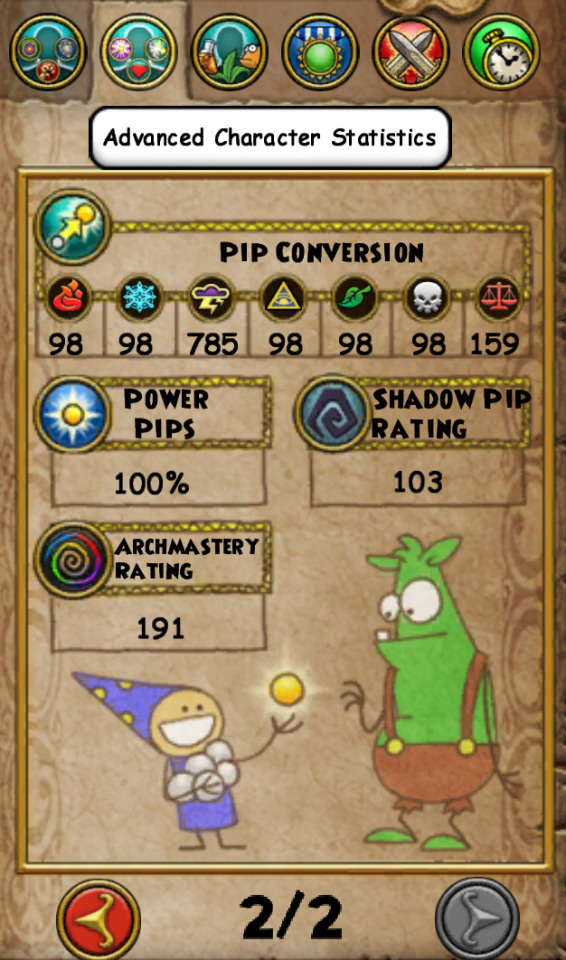
When in combat, you will see a small meter with the Shadow magic symbol on the top of where your HP is. If you mouse over your HP and the, it'll display your Shadow Gauge: the measure of how close you are to gaining a Shadow Pip. The higher your Rating is, the faster that the Gauge tends to increase.
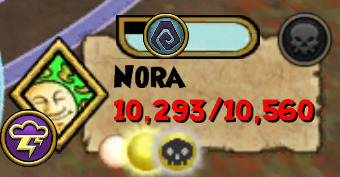

You can gain anywhere from 1% to 100% on the Gauge in a single turn, but and when the Gauge is over 100% you gain a Shadow pip, and the Gauge empties again (with no overflow.)
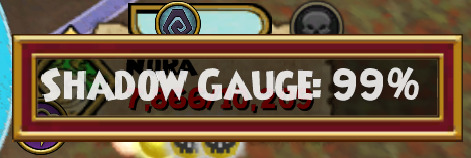
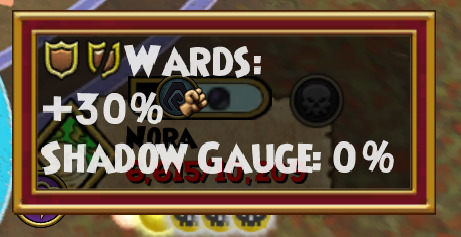
Once you get your Shadow Pips, you can use them to cast a variety of spells, which fall into one of a few categories. I will introduce these categories in the order of when they were released.
Shadow Self Spells (released in Khrysalis Part 1)
These spells transform your Wizard visually and give you a set of buffs and debuffs for three turns. They also give Backlash, represented by an orb that goes around the Wizard's head.
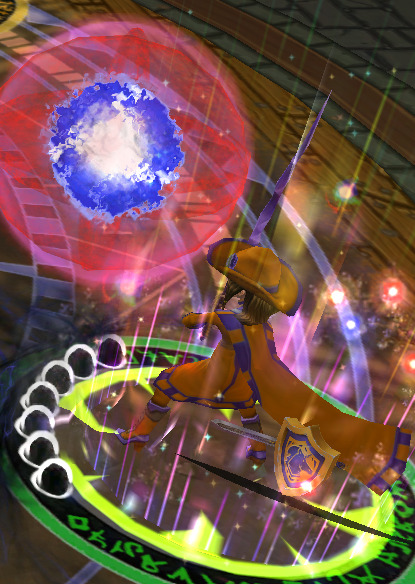
When your Shadow Self expires, the Backlash will burst on the Wizard, dealing a percentage of the Wizard's maximum health. You can decrease the amount of backlash you take by casting spells that your Shadow Self spell "likes", and increase the amount of backlash you take by casting spells that your Shadow Self "dislikes". Each of the different spells' likes and dislikes, varies from spell to spell. Both the spell's likes & dislikes as well as the stats they buff and debuff on you cater to a different playstyle.
Shadow Self spells give you a base of 40 Backlash, and casting a like or dislike decreases/increases it by 10.
Because each of the four Shadow Self spells play so differently, I will also provide a breakdown for each one.
Shadow Shrike
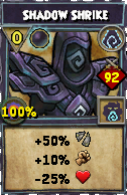
The Shrike encourages aggressive play, increasing the offensive stats of Damage and Pierce, and decreasing your incoming healing. The Shrike likes when you cast blades, traps, and attacks (the latter of which will give you and your teammates a bonus +10% pierce blade). It dislikes when you cast heals, shields, and minion-sacrifice spells, as those are defensive maneuvers.
Shadow Seraph
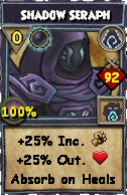
The Seraph bolsters healers, giving you boost in your outgoing heal stat while also making you more vulnerable to damage, the logic being that as a healer you can easily heal back whatever extra damage you take. It likes when you casts heals (both decreasing backlash and giving your team a shield that absorbs some extra damage) and when you sacrifice minions. It dislikes when you play aggressively by casting blades, traps, or attacks.
Shadow Sentinel
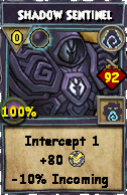
The Sentinel is built for tanks, encouraging players to redirect damage to themselves. It naturally bolsters your critical block and resist, and it makes you intercept 25% of the damage your allies take (so for example, if an enemy targets 1 ally with a spell that does 100 damage, your ally would only take 75 and you take the remaining 25). It likes when you cast shields, intercept damage, and when you Taunt the enemy (so that they can only target you), and dislikes when you cast heals or attacks.
Shadow Trickster
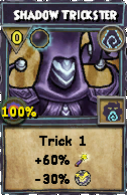
The Trickster also encourages an aggressive, glass-cannon playstyle like the Shrike, but in a different way. It increases your Critical, decreases your Critical Block, and gives you a chance to steal 1 pip from your opponent every time you target them (called Trick). As such, it likes when you target your opponents with traps or attacks, and dislikes shielding or healing yourself.
Shadow Creature Spells (Released in Khrysalis part 2)
When you cast a Shadow Creature spell, it will rise up from behind you, and in two turns it'll attack your foes. Shadow Creature spells give you a base of 30 Backlash, and casting a like or dislike decreases/increases it by 10.
All three of the Shadow Creature spells like when you buff your damage up (casting blades and traps), and dislike when you heal or shield yourself. When you cast a Like, these spells will also cast spells to buff themselves (first a Shadow blade on yourself, and then a Shadow trap on all enemies). As such, they encourage an offensive but patient playstyle.
These spells only differ in what kind of damage they do. Dark Nova attacks a single target (like your basic attacks). Dark Fiend attacks all enemies (like your AoE attacks). Dark Shepherd, like Fiend, attacks all enemies, but does less damage and instead gives you health equivalent to half of the damage it does (like the Death school's AoE drain spells of Scarecrow and Khrulu).
Shadow Enhanced Spells (First released in Darkmoor)
These spells are probably the most familiar. They function like any other attacking spell you use; they simply require a Shadow pip to cast. They give no backlash.
Like the majority of spells in-game, Shadow-enhanced spells now have Spellements. Specifically, the Arc 3 Shadow-enhanced spells (Darkmoor, Polaris, and Mirage) can be converted from being banned in Advanced Combat scenarios (PvP, raids, Challenge mode fights) to being allowed ONLY in Advanced Combat by making then require 2 Shadow Pips rather than 1.
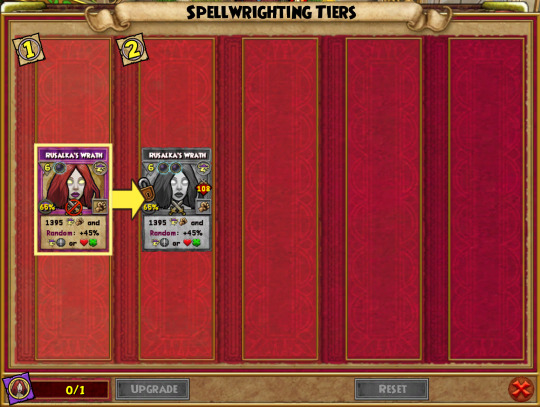
The Arc 4 Shadow-enhanced spells (Karamelle and Lemuria) have branching paths. When looking at the Spellement branch menu, the top path will always be the path intended for PvE (regular gameplay), and the bottom path will always be the path intended for PvP, though aren't banned from PvE. The top path will increase the amount of damage and the number of regular pips it costs, and not change any secondary effects the spell may have. The bottom path will also change the damage (typically an increase, but lesser) and make the spell cost 2 Shadow pips, and sometimes change the spell's secondary effects.
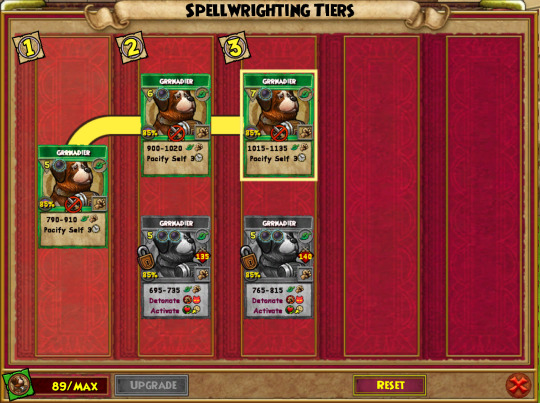
Because these spells technically aren't Shadow school spells, but rather school-specific spells given by spell quests, it is impossible to train a Shadow-enhanced spell outside of your own school. In other words, on my Fire wizard I can never learn a single Ice-school Shadow-enhanced spell, even if I have the spellements for them. (Yes I am forever bitter about this.)
Shadow Utility Spells (First released in the middle of Arcs 3 and 4)
Currently, there are two other Shadow Spells that players can learn: Donate Shadow and Dark Surge. These spells don't give any Backlash.
Donate Shadow costs 2 Shadow Pips, and lets you give one Shadow Pip to an ally (assuming they are able to acquire Shadow Pips in the first place). It became available in Empyrea Part 1. Technically you could also cast this spell on yourself, but that would be a waste of a Shadow Pip.
Dark Surge costs 1 Shadow Pip, and lets you give 2 Power Pips to yourself or an ally. It was released in late 2023.
I don't know how shadow magic works and at this point I'm too scared to ask
52 notes
·
View notes
Note
Any tips for writing the scenes you don't want to write to get to the scenes you do want to write?
Writing When It Sucks: A Quickstart Guide to the Scenes That Hate You Personally
by seth-whumps / sethlost

So, you've got a thousand-word gap between the good scenes, and you've gotta fill it with something. We've all been there—that one sentence in the outline, filling you with irreversible dread—but don’t lose hope. We do have some solutions! I've got three pieces of advice for this situation:
-> Skip The Hard Parts
-> Check Your Variables
-> Change It Up
Long post ahead, folks—you’ve been warned!
Let's start easy, with—
AVOIDANCE

Don't force yourself to write the parts you hate! If it's a scene that's not your thing, just... skip it! If you think it's boring, chances are your readers will feel it, too. If you'd skip it, they'd skip it. Famous authors do this alllllll the time. Don't deny yourself the privilege.
Remember, you don’t have to write chronologically. Write the good parts when you want to write them.
You gotta get to December? Skip to it.
You have a long ass captivity scene you don't want to bore yourself with? Skip it.
Does this scene just inspire you to stop writing forever? SKIP IT.
If it sucks, hit da bricks, as we Tumblrinas say.

Now, I hear you. "But if I do that with every scene that troubles me, I'll have hardly any scenes at all!"
Welcome to writing. It sucks. However, I'll let you in on the best tip I have ever learned from Reddit Dot Com—
CHECK YOUR VARIABLES

Your story, whether big or small, is built from several puzzle pieces! We'll call these your Story Variables. They can include:
Physical:
-> Heroes - your main people!
-> Villains - you’ve gotta have an antagonist somewhere, yknow?
-> Setting/Genre - solarpunk? ancient Arthurian myth? literally just New York City?
-> Locations - home base, headquarters, the villain’s lair, high school, etc
Narrative:
-> Main plot - getting the hero from point A to Z
-> Sideplots - character development, romance, betrayal and redemption arcs
-> Motivations - what do your characters want? what does your setting want?
-> Ending - where is it all going towards?
Audience:
-> Morals/messages - what’s the point of the story? what are you discussing or exploring throughout?
-> Metaphors - what’s the language you’re using to paint a picture?
-> Emotions - and the language you’re using to invoke a feeling?
-> Satisfaction - do you want your audience to feel satisfied? do you not? where and why?
If you're stuck on a scene, you may have an underdeveloped variable, or a missing one altogether. You can fix this by interrogating the absolute hell out of your story. Here's a few questions to get you started:
Do you know your ending? Is this scene guiding you towards it?
What emotions are you trying to portray? Where can you show that in this scene?
Where's your current location? Are you using it as a character in your story?
What drives your heroes? Your villains? How can you make them more obvious?
Are you considering your side plots and character development arcs?
Is this scene contributing to the satisfaction of your story?

You might be saying, "But wait! I'm only writing a little thing! I don't have the time/energy to think about all that!"
That's okay! I hear you. But it's not hopeless. I've still got something to help—
CHANGING IT UP

Hobbyists work in styles. It's hard to develop one, and often it comes from years of practice and study, but there's a way you can streamline it to your advantage. Think of it this way:
-> If you don't like drawing noses, change the way you draw them.
-> If your crocheting tools don't feel right, find ones that suit you.
-> If a chord on the guitar is too difficult, use an alternate fingering.
NEWS FLASH: it's the same for writing.
If something isn't working, you have every ability to do it differently. There's very little right and wrong, here. Don't confine yourself to one generalized "type" of writing--branch out until you find what works for you. Let's start by thinking about what you're struggling on.
Physical movements? Blocking? You might be having trouble visualizing what the scene needs to contain.
Draw the layout of your location. Use random pieces to represent your characters. Play dolls.
Keep it simple. Write exactly what happens, no more and no less.
Another post on Tumblr blew up, advising you to try writing the scene with only dialogue, and adding the actions later.
Emotional weight? Prose? This one's tricky, but I've got some advice regardless.
Change your sentence structure. Focus on the rhythm of the words. Worry less about grammar, and pay attention to the picture, the painting, the music.
Or, in opposition, write it exactly like it is. Come back to prose it up once you've got the scene skeletonized.
What's your moral/metaphor? Thread it throughout. Come back to it often. This'll tie up the story into something cohesive and cinematic.
Organization? The actual, nitty-gritty content of the scene? Think about what the purpose of the scene is, then consider the following.
Start with a bullet point list of everything you want to include. Think of details, interactions, and movements. Spam as many as you can think of, until you've got a substantial list of meat and seasoning you can sprinkle in as necessary.
Check in on your variables. Where does the scene need to end? What's the most convoluted path it could take to get there?
Introduce a new variable. Treat everything like a character in the story. Is the location an old building? Have it collapse. Is the ending too close for comfort? Drive the story in the opposite direction.
Most of all, mess around. Do what comes naturally, and if something isn't working, do it differently until it does. Writing is fun, despite everything about writing--so workshop it until it's fun again.

Whoops! That got very long. I hope this helps at least a bit, and if you've got any questions at all, Anon, feel free to ask! I'm sorry for the wait on this ask, by the way. I wanted to give it justice.
I'd be happy to go more in depth on anything mentioned here. I love talking through my thought processes while writing.
And as a disclaimer, none of what is said here is law. It's just what I've gathered through practice, and through following incredible people. There's no rules! Do what feels right!
Anyway! Thanks for reading, folks. See you in the next one [salutes]
Seth, signing off!

dividers by @/saradika-graphics, link in pinned post
#whump#whump community#whumpblr#whump prompt#ask answered#whump ask#writing help#writing advice#long post#whumperfly hotline#the whump advice corner
457 notes
·
View notes
Text
W101's Advanced Combat 102: School Identity and The Roshambo
Over the past few years, Wizard101 has been trying to add more variety to gameplay by introducing Advanced Combat, which focuses less on raw damage and more on hanging effects, the additional ‘things’ that can be present in battle.
In a previous post, I went over each hanging effect and their symbol, as an intro to reading spells. This post will dive further into the inner workings of Advanced Combat's logic, and lay the groundwork for understanding gambits and clears. It's somewhat of a tangent from the topic of learning how to read the spells, but I believe it's a necessary one. Simply reading spells is one thing; understanding why they work the way they do is another, and far more important in my opinion.
School Identity
In Advanced Combat, each school is represented by a hanging effect, except for Balance, because Balance is All Things. As such, when we talk about schools interacting with other schools (via synergy or countering), what's really happening is that the spells are interacting with the hanging effects associated with other schools.
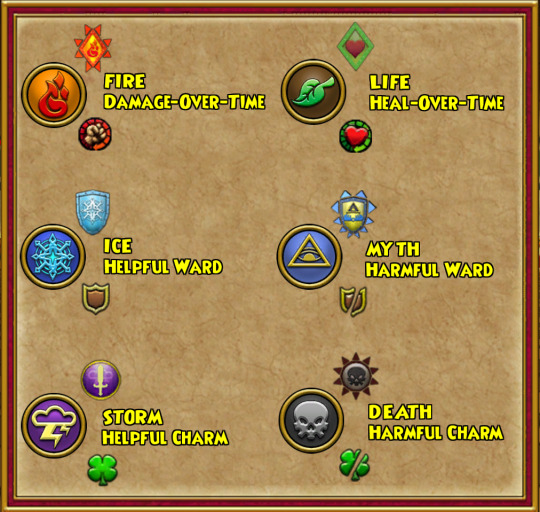
This graphic is provided in-game by the prequest, and it is a higher-res and less comprehensive version of the post I made earlier.
Each school's representative hanging effect is based partly on its previous identities, the ways each school worked before.
Fire's hanging effect is Damage over Times, as it's always been since the game first came out with its iconic DoT spells like Fire Elf, Heck Hound, Fire Dragon, and Rain of Fire.
Ice's hanging effect is Positive Wards, derived from Ice always being characterized as the tank school and getting more defensive utility than any other school (Tower Shield, Legion Shield, Frozen Armor).
Storm's hanging effect is Positive Charms, easily remembered by the most infamous wizard101 player archetype Wolf Stormblade.
Life's hanging effect is Heal over Times, because Life has always been the healer school. Think back to the 1-pip Sprite spell.
Myth's hanging effect is Negative Wards, and it's certainly the most changed from how it used to play, partly because Myth has had So many different gimmicks over the years that aren't hanging effects.
Death's hanging effect is Negative Charms, since its old-school primary mechanic of draining HP isn't a hanging effect. An easy way to remember Death as the Weakness school is to remember its utility spells of Plague, Virulent Plague, Infection, and Bad Juju.
Roshambo
Rather than having pairs of schools that are both super-effective against each other (Fire/Ice, Storm/Myth, Life/Death), each of the two Triads (i.e., Element and Spirit) has a rock-paper-scissors dynamic going on now. This system was first introduced in Beastmoon, and introduces an updated version of the School Wheel:
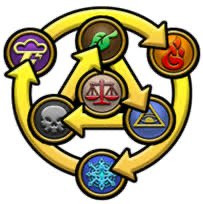
However, while this graphic is good enough for Beastmoon, I believe it can't be used to explain Advanced Combat's system unless you're already familiar with Roshambo. So I will be making my own graphics to introduce and break down the Advanced Combat Roshambos.
First, we have the Elemental Triad of Fire, Ice, and Storm.

Storm douses Fire, and Storm's immediate and hard-hitting attacks overpower Fire's slower overtime method.
Fire melts Ice, and one turn of a DoT activating can remove the shields Ice puts up and leave the Ice user vulnerable to the remainder of the DoT's damage.
Ice freezes Storm, and a Shield can block most of the damage from an otherwise buffed-up Storm hit.
Then we have the Spirit triad.
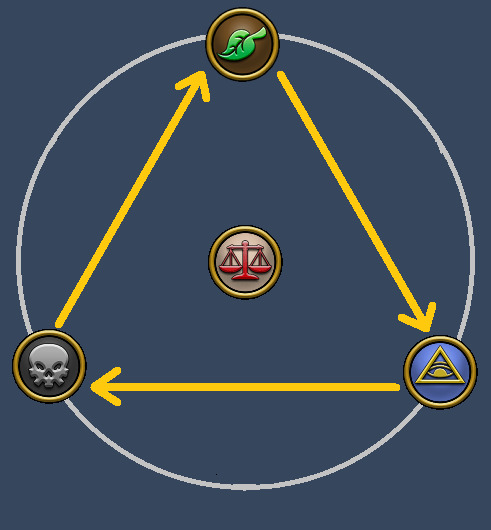
Death ends Life, and Death's many Negative Charms can hinder Life's ability to heal or attack.
Life surpasses Myth, and Life is able to heal back the extra damage that Myth would do with its traps.
Myth conquers Death, and Myth's traps can make up the lost damage that Death's weaknesses give.
And when we put the two triads together, we see relationships between Element and Spirit schools form:
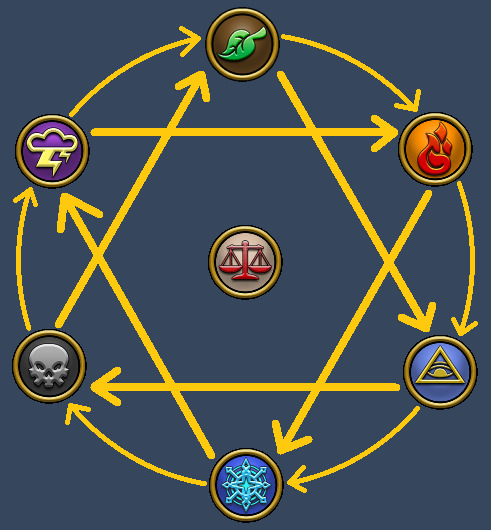
Death withers Storm, and Death's Negative Charms overpower Storm's Positive Charms.
Storm washes away Life, and Storm's immediate damage can knock out a target before they can try to heal it back.
Life survives Fire, and Life is able to heal back the gradual damage that Fire gives.
Fire burns Myth (think the Library of Alexandria), and Fire's overtimes can whittle away at Myth's traps the same way they plow through Ice's shields.
Myth shatters Ice, and Myth's infamous double-hits of old and trap spam of new can overpower Ice's defenses. (Think also of the old spell Shatter, which can remove multiple shields from a person)
Ice survives Death (think of prehistoric animals being preserved in glaciers), and Ice's defenses can keep Death from draining enough health to keep themselves alive.
Each school is able to counter two other schools, but can also be countered by two other schools. Except of course for Balance, which sits in the center of the wheel and has no arrows pointing to it. It doesn't directly counter any one school, but can't be fully countered by any one school.
A Note About Astrals
Auras (both positive and negative) aren't as immediately representative of any of the main seven schools. However, they are closer to some schools than others.

Star is situated inside the triad of Storm, Life, and Death. Following this, the developers have begun to add Auras as supplementary parts of Life and Death's identities, with Life getting Positive and Death getting Negative.
We can see this new association with Spellweaving. If you weave into Life or Death, your exclusive weaving buff is an Aura that increases the damage of your main school and Life/Death damage.

#leah speaks :3#wizard101#w101#wizblr#wizzy101#advice corner#i was going to go into some more card reading but this post was getting long enough#i'll make the final part of this masterclass tomorrow#it's getting late and these posts take a while to write
42 notes
·
View notes
Text
The Catacombs fights were *not* made to be soloed while on-level. Blanket advice before I go and look up the boss fight on my phone (bc admittedly I havent done anything Catacombs in YEARS), get yourself a group of friends that you can communicate with and form a strategy for. Take the time to plan.
Ok so I just looked the fight up. It's somewhat RNG dependent. Basically, there are four groups of minions, and each group has its own minor cheats.
Fire and Ice - if you cast a blade on someone, it'll remove all weaknesses from the person you bladed and then give itself a blade. Easily the minions you want the most.
Life and Death - if you cast a shield on someone, it'll remove the shield and cast a Tower Shield on itself. Kind of annoying.
Balance and Shadow - if you cast a weakness on an enemy, it'll remove the weakness from the enemy and cast one on you. This cheat is less annoying than Life-Death's but it's lower on the list because these mobs' normal spells are just worse to deal with IMO.
Myth and Storm - if you cast a trap on an enemy, it'll remove the trap and put a Feint on the wizard who cast it. The worst of the minions.
Prince Viggor has some cheats as well, but they're rather standard.
Every 3 rounds he'll summon another minion (if all 3 slots aren't filled already, I assume)
If you cast a feint, he removes it.
At the end of Round 2 he always casts Mass Tower Shield
He can also cheat-cast an AOE weakness, mass feint, or bladestorm.
I suggest having a main hitter, a healer, and using a mix of blades and traps for buffs. Using blades when a Fire or Ice minion is present helps you, and traps are safe from his Earthquakes so long as a Storm or Myth minion isn't around. If a Storm/Myth minion is summoned before you have all your traps up, it's easier to just reset. You can also use Indemnity to keep a single feint on Viggor for some extra buffs.
pls help
i stopped playing wiz like 2 years ago (maybe less than that?) because (other than becoming extremely busy) i COULD NOTTTT get past the catacombs :'''( stuck on prince viggor specifically
i'm just trying to farm & craft my gearrrrrr
HOW DID YOU ALL get past prince viggor like is there a strat or did you just blind join team up? is it even possible to solo? my storm is level 139 so idk why it's struggle bus central over here :'/ maybe my stats arent good? i'm not a gamer girl i'm just a lowly wizard-wannabe pls help
19 notes
·
View notes
Text
Writing Notes: On Food
A compilation of notes on how to describe food in writing.
How to Describe Food: Flavour & Texture
1. Write about the flavour.
Rich -> full, heavier foods. Often used to describe foods containing cream (e.g., potatoes & garlic, soup, and chocolate cake).
Bland -> has little or no flavour.
Bitter -> a tart, sharp, and sometimes harsh flavour (e.g., coffee).
Citrusy -> a bright flavour (e.g., lemons, limes, oranges, and other citrus fruits).
Fresh -> a light and crisp taste. Often used to describe produce or herbs. (e.g., apples, lettuce, cucumbers, carrots, etc. Or bakery items like breads, muffins, etc.)
Fruity -> any taste reminiscent of sweet fruit flavours (e.g., grapes, blueberries, peaches, etc.).
Smoky -> a taste reminiscent of the smell of smoke (e.g., BBQ).
Sour -> a biting, tangy, tart flavour (e.g., lemons, Sour Patch Kids, and other sour candies).
Sweet -> a sugary flavour (e.g., candies, ice creams, desserts, etc.).
Zesty -> a fresh, vivid, or invigorating flavour (e.g., tacos, Italian pasta salad, etc.).
2. Write about the texture:
Mushy -> soft, but in an unpleasant way (e.g., if you cook vegetables too long, they’ll get mushy).
Tough and chewy -> are similar. Both describe foods which are difficult to eat because you have to chew them for a long time (e.g., meat can be tough or chewy, especially if it’s cooked too long and it gets dry).
Tender -> similar to ‘soft’, but it’s mostly used to describe meat which is cooked well, so it’s soft and juicy.
Crunchy -> food that makes a lot of noise when you’re eating them (e.g., dry food – like potato chips, or hard cookies – can be crunchy).
Words to Describe Different Flavours
For rich, spicy, or savoury flavours. The following words represent complex, spicy, or flavourful seasonings and dishes: buttery, caramelized, peppery, piquant, salty, sapid, saporous, savoury, smoky, spicy.
For sweet or fresh flavours. These descriptors characterize fresh or sugary dishes: ambrosial, bittersweet, bright, fruity, honeyed, minty, nectarous, saccharine, sharp-tasting, sweet, syrupy, treacly, zesty.
For subtle flavours. Some dishes are on the milder side. You can use one of these words to describe the taste: bland, mellow, tasteless.
For sour flavours. A sour or complex taste can be challenging to articulate. Here are some descriptive words to help: astringent, briny, citrusy, fermented, sour, tart, vinegary.
For hard or crunchy textures. Use these words to describe a crispy or chewy texture: broiled, caramelized, crusty, flaky, leathery, sizzling, thick, thin, toasted, toothsome.
For soft or fluid textures. These words can help you describe drinks, desserts, or other soft items: crumbly, doughy, fizzy, gooey, juicy, luscious, mashed, mushy, rubbery, runny, simmered, smothered, spongy, sticky, tender, velvety, waxy.
For the smell of food. Here are common food adjectives you can use to describe smells: acrid, astringent, bright, citrusy, fermented, heady, honeyed, minty, nutty, peppery, pungent, rancid, rotten, smoky, sour, vinegary.
Tips for Describing Food in Writing
Be specific. There are a lot of food words that are vague or general, like “delicious,” “yummy,” “succulent,” “delectable,” “mouth-watering,” or “finger-licking.” Avoid these overused phrases. Focus on the food's particular flavour, texture, or smell to make your writing more evocative and precise. Rather than describing a soup as “tasty” or “scrumptious,” try more specific words like “buttery,” “chunky,” or “minty.”
Consider your purpose. Decide if your goal is to explain a culinary experience or make the food sound appetizing. A clear understanding of your intention and target audience can help you shape your writing to be the most compelling.
Evoke all the senses. While you lean heavily on taste to describe food, remember to explore the texture, smell, sight, and sound of a dining experience as well. Including sensory language that incorporates the other senses creates a more robust experience for readers.
Sometimes less is more. Food writing is most effective when it’s focused, allowing readers to zero in on the essential details of the dish. If you include too many descriptors or attach multiple adjectives to each noun, you can overwhelm or confuse readers.
Sources: 1 2 3 ⚜ More: Writing Notes & References ⚜ 100 Sensory Words
If these writing notes helped with your poem/story, please tag me. Or leave a link in the replies. I'd love to read them! Writing Resources PDFs
#writing reference#writeblr#writers on tumblr#poets on tumblr#food#creative writing#writing prompt#words#lit#writing advice#spilled ink#spilled thoughts#poets corner#poetry#writing#literature#langblr#studyblr
441 notes
·
View notes
Text
Writing Tip - How To Make Fight Scenes Interesting
More writing tips
So, when it comes to writing fight scenes, as I have done quite a few of them, there's some things I keep in mind.
Ensure Consistent Character Abilities: Characters should fight consistently throughout the scene. They shouldn’t magically become stronger or weaker without a clear reason. Consistency in their abilities helps maintain believability.
Avoid Making Heroes Invincible: I prefer not to portray heroes as invulnerable, as seen in many 80s action movies. Instead, I include moments where the hero gets hit, shows visible injuries, and shows fatigue. This makes them feel more human and improves the significance of their victories. It’s hard to create a sense of urgency if the characters don’t seem to be in real danger.
Portray Antagonists as Competent: I avoid depicting random cannon fodder as foolish by having them attack one at a time or easily get knocked out. Instead, I show them employing smart tactics such as ganging up on the hero and even getting back up after being knocked down.
Incorporate the Environment: Don’t forget to include the surroundings. Whether the fight takes place in a cramped alley, on a rain-soaked rooftop, or in a collapsing building, use the environment creatively. Characters can use objects as weapons, find cover, or struggle against challenging terrain.
Highlight Self-Inflicted Pain: Characters can hurt themselves just as much as their opponents. For instance, after landing a powerful right hook, a character might need to pause and shake off their hand in pain. This not only adds realism but also highlights the toll that fighting takes on the body.
Show Consequences After the Fight: Consider what happens after the battle concludes. Do injuries slow the hero down and limit their abilities for the rest of the story?
These are just a few tips for now. I am planning to release more tips on how I write my fight scenes with some examples included. See you then!
#creative writers#creative writing#fanfic review#fanfiction#fanfiction tips#helping writers#how to write#references for writers#review tips#wingfic#writer#writers#writers and poets#writers community#writers corner#writers on tumblr#writing#writing advice#writing community#writing help#writing inspiration#writing life#writing prompts#writing resources#writing tips#writing tips and tricks#resources for writers
2K notes
·
View notes
Text
How to Write Betrayal
Betrayal is a powerful plot element that is represented in countless stories. The gravity of betrayal brings a profound depth to character dynamics, plots, and themes alike, making it an indispensable tool for writers to explore emotions, conflicts, and the complexities of human nature. Let’s explore some quick tips on how to write betrayal!
Behaviour
Secretive actions
Dishonesty
Becoming emotionally distant
A sudden change in routine
Pushing people away
Nervous or fidgety movement
Frequent lying or making up stories
Unexpected aggression or irritability
Unjustified mood swings or emotional outbursts
Increasingly defensive
Interactions
Disturbed interpersonal relationships
Frequent misunderstandings or fights
Withholding information
Avoiding personal discussions
Insincerity in conversations
Frequently cancelling or missing plans
A sudden shift in relationship dynamics
Quick to deflect or place blame
Frequent subject changes
Gradual emotional detachment
Body Language
Avoiding direct eye contact
Defensive stance and crossed arms
Covering mouth or touching face
Shuffling or restless movements
Forcing smiles or laughter
Constantly looking around or at the ground
Stiff, tense posture
Heavy breathing or frequent sighing
Avoiding touch or skin contact
Exaggerated gestures
Attitude
A lack of concern or empathy
Increasingly personal and hurtful arguments
Erratic or unpredictable reactions
Self-centeredness
Insincerity
Dismissive or negative attitude
Callous disregard for other's feelings
A negative or pessimistic outlook
Inability to handle criticism
Withdrawal from relationships
Positive Story Outcomes
In the wake of a betrayal, a story can manifest various positive outcomes that add depth to the plot and its characters. Relationships can be strengthened, showing their resilience. Characters may discover newfound self-reliance and learn valuable lessons about trust and forgiveness, leading to an increase in empathy and understanding, personal growth, and the reinforcement of personal values. These experiences can encourage a clearer understanding of personal boundaries, prompt self-reflection, introspection, and the development of healthier coping mechanisms. Ultimately, these positive outcomes can bring about improved communication and honesty, forming the silver lining in the cloud of betrayal.
Negative Story Outcomes
The aftershocks of betrayal can reverberate throughout your story. This might include an irreparable fracture of trust and damage to relationships. Betrayal can trigger psychological trauma, leading to an increase in suspicion and insecurity. Feelings of inadequacy or self-blame may surface, and characters can experience a heightened sense of isolation. The fear of forming new relationships or trusting others can become overwhelming. There may also be an escalation of conflict or violence and the reinforcement of negative behaviours or patterns. Damaged self-esteem or self-worth may be another repercussion, and this can encourage destructive coping mechanisms.
Helpful Synonyms
Treachery
Deception
Double-crossing
Duplicity
Backstabbing
Two-faced
Disloyalty
Unfaithfulness
Infidelity
Falseness
Perfidy
Treason
Fraud
Deceit
Slander
Misrepresentation
Falsification
Chicanery
Double-dealing
#writers#creative writing#writing#writing community#writers of tumblr#creative writers#writeblr#writerblr#writing inspiration#writing tips#writblr#writers corner#writing quick tips#quick writing tips#writing resources#writing advice#writer#on writing#writers block#beat writers block#let's write#writing betrayal#writing emotions#character development#writing characters#advice for authors#references for writers#helping writers#writing help#help for writers
6K notes
·
View notes
Text
This translates to: "If there is 1 trap on the target, remove it and give the target 2 -20% damage weaknesses. Then do 135 Ice damage."
Here's the breakdown.


Hey what the fuck does this even say
17 notes
·
View notes
Text
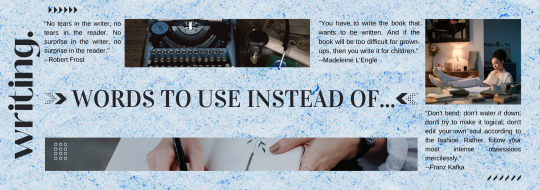
Said is dead, and so are some other words that we writers tend to overuse. Here's a brief list to aid your brain:
01. "VERY" ☆★⋆⭒˚.⋆
Very angry -> Furious
Very beautiful -> Gorgeous
Very bog -> Massive
Very boring -> Dull
Very poor -> Destitute
Very cheap -> Stingy
Very clean -> Spotless
Very difficult -> Arduous
Very dry -> Arid
Very quick -> Rapid
Very strong -> Forceful
Very ugly -> Hideous
Very calm -> Serene
Very huge -> Colossal
Very small -> Petite
02. "WHISPERED" 🤫
Murmurd
Mumbled
Muttered
Breathed
Sighed
Hissed
Mouthed
Susurrated
Intoned
Purred
Said in an undertone
Hinted
Said low
Said in hushed tones
Gasped
03. "BAD" 😈
Corrupt
Sinful
Depraved
Contaminated
Tainted
Irascible
Atrocious
Sinister
Snide
Deplorable
Detestable
Execrable
Ghastly
Noxious
Substandard
Despicable
Contemptible
Foul, rank, faulty
04. "BEAUTIFUL" 🦋
Dazzling
Splendid
Magnificent
Aesthetic
Delicate
Glorious
Stunning
Heavenly
Resplendent
Radiant
Glowing
Blooming
Sparkling
05. "BEGIN" ▶️
Open
Launch
Initite
Commence
Inaugurate
Originate
06. "BIG" ⚡
Immense
Gigantic
Vast
Gargantuan
Sizable
Grand
Mammoth
Astronomical
Titanic
Mountainous
If you like my blog, buy me a coffee! ☕
🖱️References
https://www.pinterest.com/pin/2603712279594924/
https://www.pinterest.com/pin/81627811987512761/
#writer#writers#creative writing#writing#writing community#writers of tumblr#creative writers#writing inspiration#writeblr#writing tips#writers corner#writers community#poets and writers#writing advice#writing resources#writers on tumblr#writers and poets#helping writers#writing help#writing tips and tricks#how to write#writing life#let's write#resources for writers#references for writers#vocabulary#words#on writing#writer stuff#description
4K notes
·
View notes
Text
How to Ignore Magical Healing
One of the things I encounter often in media or when writing is the existence of magic, and therefore healing spells. In most magic systems, it renders long-term whump, recovery, or even classic medical tending unnecessary, or just irrelevant. That can be discouraging and uninspiring at times.
We can’t all choose what world The Blorbo™ heralds from, so sometimes we get stuck with a universe that complicates the whump instinct. So, here are some prompts for avoiding magical healing in your whumping!

Wound-based
Prompts that prevent wounds from healing
It’s Just TOO Bad: Uh oh, the healing isn’t working because the wound itself is too bad to fix
Unnatural Origins: The healing isn’t working because the wound itself isn’t natural and so cannot be healed by magical means OR the whumpee is inhuman/the in-universe equivalent, and the magic doesn’t recognize them as something that can be healed (robots, aliens, vampires, etc)
Ailments: The Whumpee has a curse/illness (like the Malady effect in Metaphor: ReFantazio) preventing them from healing at all, so that ailment must be cured before they can heal up
Prior Requirements: Something must be done before a healing spell can be cast (removing a bullet so it doesn’t fester, stitching the wound so it can heal smoothly)
Poison: The weapon was laced with a poison that, amongst its many effects, is preventing any healing magic from reaching the wound

Situation-based
Prompts to stop your party from casting because of the predicament they’re in
Exhaustion: The party is already at their limits, and they can’t afford another healing spell OR the party doesn’t want to spend anymore magic until it’s absolutely necessary OR The party has already used all of the items in their disposal that provide magical healing (like life stones in SMT)
Prevention: The party cannot reach Whumpee to heal them (barriers, cells, or perhaps the party is otherwise occupied by fighting?)
Dangerous Territory: If the party were to stop and heal Whumpee, they would waste precious time/make too much noise/put themselves in a bad place, so Whumpee has to make it a little further before they can fix the problem
Fear Response: Whumpee has prior poor experiences with magic or healing, and is refusing treatment for as long as they can hold out OR whumpee is magically convinced the party is going to hurt them (fear effects, brainwashing, feeblemind spell in D&D)
Magic Nullification: Magic isn’t allowed (a tournament) or possible (area of effect magic prevention) and the team must make do without

Universe-based
Prompts to engineer/alter the universal requirements to stop magical healing
Risky Measures: Healing spells rely on the wounded person’s energy. If a powerful spell is cast on a poorly off Whumpee, it could use the last of Whumpee’s energy, and kill them
Exchange Theory: Any pain healed on Whumpee is transferred to the person casting the healing spell OR the wound itself is transferred onto someone else
Fine Print: This particular healing spell requires a very specific item (like diamonds in resurrection for D&D) and the team has to find/buy it before they can heal the whumpee
It Just Hurts: Healing spells don’t include pain relief, so when casted, Whumpee can feel every part of their wounds healing (like bones readjusting or flesh stretching)
They Don’t Exist: Healing spells themselves don’t exist, and instead creative ways of wound care are invented like slowing down blood flow or encouraged immune system responses

Final notes
Something you can play with here is if the characters have never practiced first aid! Your caretakers might have no idea how to pack a wound or splint a fracture. Lots of mistakes and tension can grow from there.
Don’t be afraid to alter the universe you’re writing in. Fuck it up, really. There’s something enchanting about adding specific rules in a given world. Adding those requirements gives depth you can play in as a sandbox. Or you can throw the team into a completely different universe, if that’s your fancy!
And remember: you never need to write it realistically. Ignore the healing spells, throw the whumpee in a no-magic AU, hell, just take healing away from those specific people to prevent it–do whatever you want, whatever seems interesting, and have fun doing it. There’s no need to make it seamless. Make it bloody first.
Now, go beat the shit out of your blorbos.
Love yall!
- Seth

post dividers by @/saradika-graphics
#whump#whump community#whumpblr#whump prompt#whump tips#whump advice#whump advice corner#sethtalks whump#healing whump#fantasy whump#magic whump#the whump advice corner
205 notes
·
View notes
Text
YOU— YEAH YOU! DO THIS THING WITH ME!
THIS IS YOUR AGGRESSIVE SIGN TO CREAT EVERY DAY FOR ONE YEAR.
Okokokokok so the goal is essentially what I said above. Write/draw something every day for a year. I know that sounds like A LOT but even if you can spare 2 minutes in your day to quickly scrible something into your notes app that's perfect.
Why should you bother with this?
You will end up at 365 pieces by the end of the year
you will improve your skills
you are bound to find some gold
even if you miss 1/3 of the days you will still have 243 things!!!
helps you be more in tune with your feeling (especially if you treat it like a journal)
you can try out different styles in a judgement free zone
uhhhh you love me
you will learn how to be more creative
you will have content to post on your blog/publish/submit to contests
you will have something to keep you going/motivated
you won't be alone
AND LOTS OF OTHERS I DONT HAVE TIME FOR
So this is your sign to write with me
(don't worry about starting on the same day just start making stuff)
I will be posting the things I write on @rheas-poetry-motivation
JOIN ME 🫵
Tagging people for reach and cause i love my moots:
@mister-dirty-hands, @bamb1fawn, @outromoony, @themortalityofundyingstars, @garden-of-runar
@ancientpokemonrock, @ang3lic-t3ars, @justiceforplutoo, @albatris, @gayafaaryn
@lorelangdon, @imastoryteller, @chaoticcandle, @gildy-locks, @jamespotterbbg
@seekmemystar, @tequilaqueen, @picklerab23, @a-k-oblackhat, @leahnardo-da-veggie
#writing blog#creative writing#writerslife#young writer#writers#writerscommunity#writers on tumblr#writblr#writing advice#am writing#writers block#writing#writing humor#writeblr#writers and poets#artistsontumblr#artists on tumblr#digital artist#small artist#oc artist#poems on tumblr#poets on tumblr#poets corner#writing process#writer#on writing#creative writers#fanfic review#fanfiction#fanfiction tips
274 notes
·
View notes